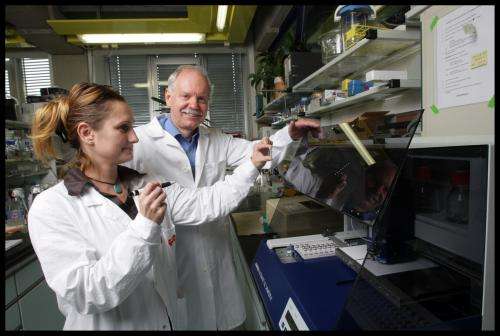Biochemists discover 'parking position' of fat-burning enzymes

Fat is a curse and a blessing at the same time. While we would rather not have any fat deposits on our body, especially in summer, accumulated fats in plants are desirable as they make them especially nutritious. Biochemists from Graz University of Technology demonstrated in 2010 that two enzymes of the fat metabolism have a twofold function, being responsible both for the breakdown and the metabolic formation of fats. When they investigated the fat depleting function, Günther Daum and doctoral candidate Claudia Schmidt from the Institute of Biochemistry of Graz University of Technology found that the enzymes are "parked" under certain conditions and suspend the breakdown of fat. The result was recently published in the renowned Journal of Biological Chemistry.
Our knowledge about human and plant fat metabolism is often derived from scientific studies with yeast, which often serves as a model system with high relevance for higher organisms. Enzymes – i.e. proteins which, as biocatalysts, trigger certain reactions – are a key factor in the metabolism of fat. A team led by Günther Daum from the Institute of Biochemistry of the University of Technology of Graz demonstrated approximately three years ago that two specific, fat-splitting yeast enzymes have a twofold function. They can both build and break down fat. "We decided to take a closer look at one of these two enzymes and investigated the regulation of lipogenesis and lipolysis in terms of biochemistry, molecular biology and cell biology under various conditions", says Günther Daum.
Parked enzyme
For instance, the researchers "switched off" the synthesis of the triglycerides, i.e. of the fats belonging – like cholesterol – to the dietary and depot fats. After this manipulation, the yeast cell is not capable of producing lipid particles any more, which are usually the site where the fat depleting enzyme (lipase) is localized. The now "homeless" enzyme migrates to the endoplasmic reticulum, the cell's "synthesis power plant". "The reaction of the yeast enzyme was surprising – because there was none at all. It changed its position, but then it went into a kind of 'on-hold state' without fulfilling any function. There were no enzyme activities any more", says Daum. Although the result is surprising, it is not illogical: "The enzyme is parked, but when called upon it is able to restart both its lipolysis and lipogenesis activity", he explains. This made the researchers conclude that the site of the enzyme within the cell decisively influences its function.
By investigating the yeast enzymes, the biochemists wanted to research the processes of the fat metabolism and thereby contribute to the transferable knowledge of lipogenesis and lipolysis in humans and plants. In this context, it is crucial to understand each factor's particular impact on the activity of the fat-splitting enzymes. The study was carried out as part of an FWF sponsored research project and is part of Claudia Schmidt's dissertation. The renowned Journal of Biological Chemistry recently published the results.
More information: Schmidt, C. et al. Regulation of the Yeast Triacylglycerol Lipase Tgl3p by Formation of Nonpolar Lipids, The Journal of Biological Chemistry, Vol 288, No. 27. 19939-19948. 2013.
Journal information: Journal of Biological Chemistry
Provided by TU Graz

















